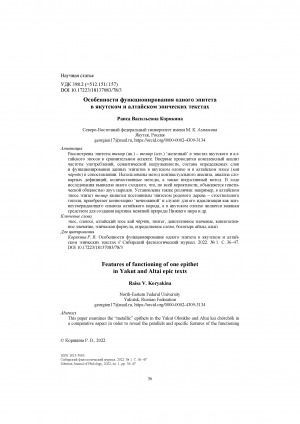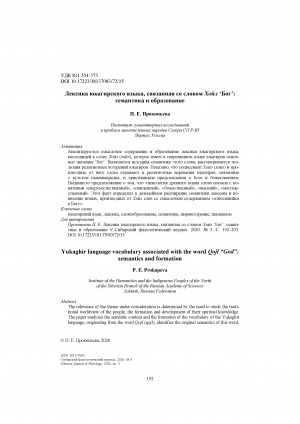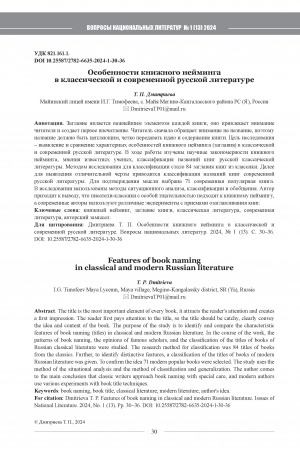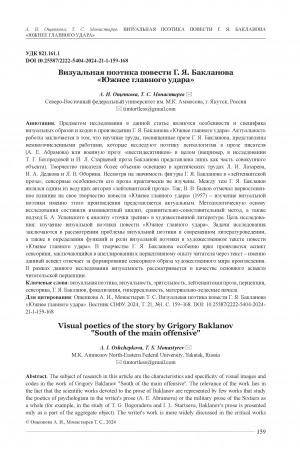- Книга (6970)
- Журнал (249)
- Автореферат диссертации (191)
- Аудиоиздание (750)
- Видеоиздание (659)
- Неопубликованный документ (17)
- Нотное издание (7)
- Фотография (4)
- Статья (958)
- Библиографический указатель (51)
- Словарь (209)
- Календарь (2)
- Брошюра (104)
- Буклет (1)
- Электронное издание (1)
- Грампластинка (19)
- Веб-архив (289)
- Азербайджанский (1)
- Чукотский (18)
- Долганский (10)
- Английский (59)
- Эскимоский (1)
- Эвенкийский (56)
- Эвенский (135)
- Французский (29)
- Немецкий (10)
- Хантыйский (1)
- Казахский (5)
- Корякский (3)
- Корейский (1)
- Мансийский (1)
- Нанайский (6)
- Ненецкий (3)
- Нивхский (5)
- Старорусский (6)
- Осетинский (1)
- Польский (1)
- Русский (5581)
- Латинская графика (214)
- Тунгусский (3)
- Турецкий (19)
- Тувинский (5)
- Якутский (4273)
- Юкагирский (35)
Количество страниц: 12 с.
- Общественные науки. Образование > Народное образование. Воспитание. Обучение. Организация досуга > Общеобразовательная школа. Дошкольные учреждения,
- Языкознание. Филология. Художественная литература > Языкознание и языки. Лингвистика > Эвенкийский язык,
- НАУКА ЯКУТИИ > ЯЗЫКОЗНАНИЕ. ФИЛОЛОГИЯ. ЛИТЕРАТУРОВЕДЕНИЕ. ХУДОЖЕСТВЕННАЯ ЛИТЕРАТУРА > Языкознание и языки. Лингвистика,
- НАУКА ЯКУТИИ > ОБЩЕСТВЕННЫЕ НАУКИ > Народное образование. Воспитание. Обучение. Организация досуга > Общеобразовательная школа. Дошкольные учреждения.
The main purpose of the study was to analyze the lexical units involved in the representation of the URE ‘mountain’ concept in the language picture of the world of the Evenks. The identification of word meanings involved the examination of bilingual dictionaries of the Evenk language and field records of authentic texts narrated by informants who knew the Evenk and Russian languages well. According to the source study, the lexemes ure , a , and are the most commonly used representations of the concept URE in the Evenks’ world picture. The analysis revealed the meaning of lexemes ure , a , and allowed their semes to be identified. The ure lexeme was found to have the semes: ‘overgrown with trees,’ ‘low hill,’ ‘inhabited by moose, bears, and other wild animals,’ and ‘master spirit of the mountain.’ The following semes were found for the lexeme : ‘stony,’ ‘covered with grass or reindeer moss,’ ‘inhabited by wild deer,’ ‘suitable for residence in summer,’ suitable for roaming,’ ‘suitable for deer grazing in summer,’ and ‘a good place for hiding deers from wolves.’ The lexeme is characterized by the semes: ‘rocky,’ ‘high,’ ‘made of stones,’ ‘cool place,’ and ‘inhabited by bighorn sheep, tarbagans, and musk deer.’ A conclusion is made that the URE ‘mountain’ concept formation was influenced by Evenks’ hunting and nomadic lifestyle combined with their animistic views on nature. The URE ‘mountain’ concept is a part of the BUGA ‘world’ concept structure.
Ушницкая, Н. Ю. Репрезентация концепта УРЭ ‘гора’ в языковой картине мира эвенков / Н. Ю. Ушницкая ; Институт гуманитарных исследований и проблем малочисленных народов Севера // Сибирский филологический журнал. - 2023. - N 4. - С. 287-298. - DOI: 10.17223/18137083/85/21
DOI: 10.17223/18137083/85/21
Количество страниц: 14 с.
The paper presents a structural description of the terminological phrases relating to the thematic group “Livestock body parts” in the Yakut and Buryat languages. These lexical units refer to the folk terms reflecting the features of the material and spiritual culture of an ethnic group and are widely used in languages of very different typologies. Such phrases are formed analytically, representing non-single-word nominative units denoting one specific concept or real object. Their lexical meaning can be realized at the denotative and/or connotative levels. The terminological phrases under study occupy a special place in the lexicon of the languages in question as an effective way of creating terms. Word pairs are a part of this vocabulary group. An active way of compound word formation in Yakut and Buryat is the method of adjunction used to form attributive phrases with an adjective or a participle as an attribute. Both languages feature terminological phrases formed morphologically. Such phrases have an attributive function, designating a part of a whole object or a type of a generic concept, with the determining component occupying the preposition. In Yakut, these phrases have their components connected by the possessive affix of the third person. Buryat terms denoting animal body parts are formed by a combination with the determining component in the genitive case. It is noteworthy that in Yakut nominal constructions, the indicator of the connection between the components is attached to the component being determined, while in Buryat, it is attached to the determining one.
Данилова, Н. И. Терминологические словосочетания, обозначающие части тела скота, в якутском языке (в сопоставлении с бурятским) / Н. И. Данилова, Ф. Н. Дьячковский ; Институт гуманитарных исследований и проблем малочисленных народов Севера // Сибирский филологический журнал. - 2023. - N 4. - С. 197-210. - DOI: 10.17223/18137083/85/15
DOI: 10.17223/18137083/85/15
Количество страниц: 14 с.
This paper addresses the semantics of dialectal names of mutovka (a stick with branches at the end used for mixing or stirring), with all of them belonging to the lexical-thematic microgroup “Utensils” in the Yakut language. Over 40 dialect names of mutovka with different connotations have been identified in dialectological, lexicographical, and ethnographic materials. The nomination principles of mutovka are determined on the external form and functions. The form and structure of mutovka s (round, branched, cross-shaped), material (wood, cow horn) depend on their purpose. Mutovka has different functions: for whipping koumiss, cream, or butter, and others, with the movement of the tool also of importance for nomination. The basic characteristic of any mutovka is ytyyyy “mixing, stirring, and churning.” The comparative analysis revealed that the Yakut lexemes ytyk and bhiheyeh indicate a common Turkic similarity. Most names of mutovka are part of the lexical fund of the Yakut language developed in the linguistic landscape of modern Yakuts (Sakha). Also, the dialect names bilier, biriel “kumys mutovka” have been found to have Mongolian roots. A semantic description allowed the origin of khamnatar “kumys mutovka” to be determined as an apotropaic lexeme with both all-Yakutian and dialectal meaning. The semantics of the mutovka names concerned reflects the cattle-breeding culture of Yakuts (Sakha) developed and spread in the subcontinental climate in the vast territory of the North-East of Russia. The findings specify the lexical-semantic microgroups “Tableware,” “Utensils” to “Kumys ware and utensils,” “Ytyk,” to compile the thematic lists of Yakut household culture.
Николаев, Е. Р. Диалектные наименования мутовки в якутском языке (на материале лексикографических источников) / Е. Р. Николаев ; Институт гуманитарных исследований и проблем малочисленных народов Севера // Сибирский филологический журнал. - 2023. - N 2. - С. 194-207. - DOI: 10.17223/18137083/83/15
DOI: 10.17223/18137083/83/15
Количество страниц: 12 с.
- Языкознание. Филология. Художественная литература > Языкознание и языки. Лингвистика > Якутский (саха),
- Языкознание. Филология. Художественная литература > Языкознание и языки. Лингвистика > Другие языки,
- НАУКА ЯКУТИИ > ЯЗЫКОЗНАНИЕ. ФИЛОЛОГИЯ. ЛИТЕРАТУРОВЕДЕНИЕ. ХУДОЖЕСТВЕННАЯ ЛИТЕРАТУРА > Языкознание и языки. Лингвистика.
This paper examines the “metallic” epithets in the Yakut Olonkho and Altai kai chӧrchӧk in a comparative aspect in order to reveal the parallels and specific features of the functioning of these epithets in the epic of peoples related in the historical past. The following methods were used: contextual analysis, analysis of dictionary definitions, quantitative methods, and the inductive method, which allows generalizing the results of applying all the methods. The comparative study revealed many similarities. In both epics, metal epithets in the structure are radical, derived from the lexeme denoting the name of the metal. In a denotative meaning, they characterize objects by the material from which they are made. The choice of specific metallic epithets as contextual synonyms in the structure of the epic formula is due to the phenomenon of vowel harmony inherent in most Turkic languages. The genetic community of the Yakut and Altai peoples probably explains the similar features of the metallic epithets. Also, the differences have been established: according to the frequency of using the epithets formed from the nominations of precious metals, the ancient Yakuts preferred silver, and the Altai people preferred gold. The differences and peculiarities of functioning of “metal” epithets in the Yakut and Altai epic texts can be explained by the stage difference in the development of the epic texts compared.
Корякина, Р. В. Особенности функционирования одного эпитета в якутском и алтайском эпических текстах / Р. В. Корякина ; Северо-Восточный федеральный университет им. М. К. Аммосова // Сибирский филологический журнал. - 2022. - N 1. - С. 36-47. - DOI: 10.17223/18137083/78/3
DOI: 10.17223/18137083/78/3
Количество страниц: 12 с.
The relevance of the theme under consideration is determined by the need to study the traditional worldview of the people, the formation and development of their spiritual knowledge. The paper analyzes the semantic content and the formation of the vocabulary of the Yukaghir language, originating from the word Qojl (qojl), identifies the original semantics of this word, examines the evolution of the religious beliefs of the Yukaghir. The word Qojl (qojl) is associated originally with shamanistic beliefs and was representing the image of the shaman-patron of the family in the traditional culture of the Yukaghir. Later, it came to be referred to the name of the Christian God and to designate icons and saints. In the modern Yukaghir language, the word concerned is used only in the meanings of “God,” “divinity,” “icon,” “saint.” The prevalence of Qojl (qojl) - derived words in the languages of two local Yukaghir groups, the similarity of the structure and meanings of many of the lexemes indicate the archaicity of the word and the presence of a semantic relationship between the original and late sememes. An assumption has been made that the etymology of the ancient root of the word is associated with the concepts of “supernatural,” “sacred,” “divine,” “supreme,” “powerful.” The fact that the word originally comprised the concept of the supernatural and divine determined the expansion of the semantics of the word. Under the influence of Christianity, new words derived from Qojl ( qojl ), with the semantic content “referring to God,” appear in the Yukaghir language.
Прокопьева, П. Е. Лексика юкагирского языка, связанная со словом Хойл ‘Богʼ: семантика и образование / П. Е. Прокопьева ; Институт гуманитарных исследований и проблем малочисленных народов Севера СО РАН // Сибирский филологический журнал. - 2020. - N 3. - С. 76-80. - DOI: 10.17223/18137083/72/15
DOI: 10.17223/18137083/72/15
Количество страниц: 7 с.
- Языкознание. Филология. Художественная литература > Литература. Литературоведение > Теория литературы. Изучение литературы. Литературная техника > Художественная литература на отдельных языках,
- НАУКА ЯКУТИИ > ЯЗЫКОЗНАНИЕ. ФИЛОЛОГИЯ. ЛИТЕРАТУРОВЕДЕНИЕ. ХУДОЖЕСТВЕННАЯ ЛИТЕРАТУРА > Литература. Литературоведение.
Дмитриева, Т. П . Особенности книжного нейминга в классической и современной русской литературе / Т. П. Дмитриева ; Майинский лицей имени И. Г. Тимофеева // Вестник Северо-Восточного федерального университета им. М. К. Аммосова. Серия "Вопросы национальных литератур". - 2024. - N 1 (13). - С. 30-36. - DOI: 10.25587/2782-6635-2024-1-30-36
DOI: 10.25587/2782-6635-2024-1-30-36
Количество страниц: 8 с.
- Языкознание. Филология. Художественная литература > Литература. Литературоведение > Теория литературы. Изучение литературы. Литературная техника > Художественная литература на отдельных языках,
- НАУКА ЯКУТИИ > ЯЗЫКОЗНАНИЕ. ФИЛОЛОГИЯ. ЛИТЕРАТУРОВЕДЕНИЕ. ХУДОЖЕСТВЕННАЯ ЛИТЕРАТУРА > Языкознание и языки. Лингвистика.
Teki Odulok's travel essay is the first work devoted to a journey through the northernmost regions of the Russian Federation undertaken by a compatriot, a representative of the smallest Russian people - the Yukaghir, in the 20s of the twentieth century. The article presents the results of the study of the content of the travelogue, its chronotopes, descriptions of nature at different geographical latitudes, culture and life of the unique endemic peoples inhabiting the territory: the Yukaghirs (Oduls), Russian-Ustintsy, Chukchi, Evens, Evenks (Lamuts). It is proven that the work is a narrative, objectively related to the history and geographical location of the region, political and cultural events in the Soviet Union at the beginning of the twentieth century. The novelty is justified by the fact that the essay has the characteristics of a travelogue in the modern sense, and therefore the readers, regardless of their nationality and place of residence, perceive it with interest. The influence of the professional view of a scientist-economist on the style of literary narration is shown, which provides an enriched description of travel along a specific route and an evidential connection with the modern economic state of the regions described. Complete discourses combining documentary narration, presentation of real facts about harsh conditions of survival and description of life and customs of representatives of small number of peoples - endemics - are highlighted. Methods of comparison and literary retroscopy were used, which allowed to confirm the author's assumptions about the development of the region in literary and documentary form. The article may be of interest not only to philologists and specialists in the field of national cultures, but also to interested readers.
Третьякова, Т. В. Путевой очерк Тэки Одулока "На Крайнем Севере" – первый травелог начала ХХ века / Т. В. Третьякова ; Северо-Восточный федеральный университет им. М. К. Аммосова // Вестник Северо-Восточного федерального университета им. М. К. Аммосова. - 2024. - Т. 21, N 1 (95). - С. 178-185. - DOI: 10.25587/2222-5404-2024-21-1-178-185
DOI: 10.25587/2222-5404-2024-21-1-178-185
Количество страниц: 9 с.
- Языкознание. Филология. Художественная литература > Литература. Литературоведение > Теория литературы. Изучение литературы. Литературная техника > Художественная литература на отдельных языках,
- НАУКА ЯКУТИИ > ЯЗЫКОЗНАНИЕ. ФИЛОЛОГИЯ. ЛИТЕРАТУРОВЕДЕНИЕ. ХУДОЖЕСТВЕННАЯ ЛИТЕРАТУРА > Языкознание и языки. Лингвистика.
The research is carried out in the context of interdisciplinary cognitive directions - cognitive linguistics and cognitive poetics, one of the actual tasks of which is modeling the structure of artistic concepts represented in the artistic text. The aim of the study is modeling of the artistic concept of cold in the author’s artistic picture of the world of Y. S. Rytkheu as a part of the conceptosphere of the Arctic discourse. This research is the first stage in the study of artistic concepts in the Arctic discourse of Y. S. Rytkheu. The novel of this Chukchi writer, who is a representative of the northern linguoculture, was analysed. The relevance of this study is determined by the choice of the concept of cold as one of the key discursive concepts of the North and the Arctic, as well as its inclusion in the paradigm of linguocognitive research and conceptology of the artistic text. The method of continuous sampling was used to extract 456 markers - representatives of the concept. The markers were distributed into lexico-thematic groups (hereinafter - LTG) “Nature” (211), “Human Impact” (142), “Dwelling” (44), “Technology” (39), “Equipment” (20), interpreted as cognitive attributes of the concept. The distribution into LTGs was made according to the signs of semantic and thematic commonality of the concept markers. The following structure of the artistic concept cold was revealed: in the nuclear zone there is the cognitive attribute “Nature” (211 markers), in the ancillary zone - “Human Impact” (142 markers), in the near periphery there is the attribute “Dwelling”, in the far periphery “Equipment” and “Technics”. Such cognitive features of the artistic concept of cold as the Arctic climate of Chukotka, natural phenomena associated with cold, the impact of cold on people and their activities are defined.
Павлов, С. С. Художественный концепт холод в произведении чукотского писателя Ю. Рытхэу "Айвангу" / С. С. Павлов, О. А. Мельничук ; Северо-Восточный федеральный университет им. М. К. Аммосова // Вестник Северо-Восточного федерального университета им. М. К. Аммосова. - 2024. - Т. 21, N 1 (95). - С. 169-177. - DOI: 10.25587/2222-5404-2024-21-1-169-177
DOI: 10.25587/2222-5404-2024-21-1-169-177
Количество страниц: 10 с.
- Языкознание. Филология. Художественная литература > Литература. Литературоведение > Теория литературы. Изучение литературы. Литературная техника > Художественная литература на отдельных языках,
- НАУКА ЯКУТИИ > ЯЗЫКОЗНАНИЕ. ФИЛОЛОГИЯ. ЛИТЕРАТУРОВЕДЕНИЕ. ХУДОЖЕСТВЕННАЯ ЛИТЕРАТУРА > Языкознание и языки. Лингвистика.
The subject of research in this article are the characteristics and specificity of visual images and codes in the work of Grigory Baklanov "South of the main offensive". The relevance of the work lies in the fact that the scientific works devoted to the prose of Baklanov are represented by few works that study the poetics of psychologism in the writer's prose (A. E. Abramova) or the military prose of the Sixtiers as a whole (for example, in the study of T. G. Bogoradova and I. L. Startseva, Baklanov's prose is presented only as a part of the aggregate object). The writer's work is more widely discussed in the critical works of L. I. Lazarev, I. A. Dedkov and L. V. Oborin. Despite the importance of the figure of Grigory Baklanov in the "lieutenant prose", the sensual features of his prose are practically not studied. Meanwhile, Grigory Baklanov was one of the leading authors of "lieutenant prose". Thus, V. V. Bykov noted the primary influence on his work of the story "South of the main offensive" (1957) - the study of the visual poetics of this very work seems relevant. The methodological basis of the research was the immanent analysis, the comparative-comparative method, as well as B. A. Uspensky's approach to the analysis of the "point of view" in fiction. Aim of the research is to study the visual poetics of the story "South of the main offensive". The aim of the study is to consider the problem of visual poetics in modern literary studies, as well as to determine the functions and role of visual poetics in the artistic text of the story "South of the main offensive". In the work of Grigory Baklanov, the aspect of sensory poetics, which consists in appealing to the reader's perceptual experience through the text, is particularly pronounced - it is this aspect that is responsible for the formation of the sensory image of the artistic world of the work. In this study, visuality is considered as the main aspect of the reader's perception.
Ощепкова, А. И. Визуальная поэтика повести Г. Я. Бакланова "Южнее главного удара" / А. И. Ощепкова, Т. С. Монастырев ; Северо-Восточный федеральный университет им. М. К. Аммосова // Вестник Северо-Восточного федерального университета им. М. К. Аммосова. - 2024. - Т. 21, N 1 (95). - С. 159-168. - DOI: 10.25587/2222-5404-2024-21-1-159-168
DOI: 10.25587/2222-5404-2024-21-1-159-168
Количество страниц: 12 с.
- Языкознание. Филология. Художественная литература > Литература. Литературоведение > Теория литературы. Изучение литературы. Литературная техника > Художественная литература на отдельных языках > Якутская (саха) литература,
- НАУКА ЯКУТИИ > ЯЗЫКОЗНАНИЕ. ФИЛОЛОГИЯ. ЛИТЕРАТУРОВЕДЕНИЕ. ХУДОЖЕСТВЕННАЯ ЛИТЕРАТУРА > Языкознание и языки. Лингвистика.
In recent years, an active appeal to the discourse of cold as a scientific problem has been observed in science, which is partly due to some extent to the transformation of the worldview of modern man, partly to the awareness of the fragility of the world balance in a globalising space. At the same time, the lack of development of the methodology, which consists in the absence of a conceptual, informational base, separate tools, creates difficulties in implementation this problem. In this regard, the topic presented in this article undoubtedly has great scientific potential and novelty in the context of the problem of geo-culture of the North. The purpose of the study is to study the concept of cold in the context of the geo-cultural landscape of Yakutia as a semantic structure, which manifests itself in the constancy of images, universals with cultural, historical, mental community and united in a single artistic system. The author pays special attention to the reception of the concept of cold in the aspect of binary positions of one's own and another's, where one's own is represented by an associative series of native, close, bright, safe, and participates in the formation of unique characteristics of the national world. The main attention is paid to the initial properties of cold, which form the borders of the Yakut world and participating in the design of a specific mental picture of Sakha, which is quite clearly reflected in the images of the initiating heroes of P.A. Oyunsky. In addition, the subject of the study is also the specifics of cold and its role in the actualisation of the unique geo-cultural quality of the city of Yakutsk as the coldest, most distant city, “the city on the edge”. The methods used in the article were systemic, structural research methods. Results. The study of this concept in the literary aspect helps to identify the peculiarities of the individual style, the author's position, and the peculiarities of constructing a national picture of the world.
Ноева, С. Е. Поэтика холода в якутской прозе начала ХХ века: холод как граница якутского мира / С. Е. Ноева (Карманова) ; Институт гуманитарных исследований и проблем малочисленных народов Севера // Вестник Северо-Восточного федерального университета им. М. К. Аммосова. - 2024. - Т. 21, N 1 (95). - С. 147-158. - DOI: 10.25587/2222-5404-2024-21-1-147-158
DOI: 10.25587/2222-5404-2024-21-1-147-158









